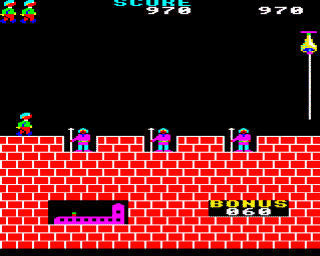The previous post introduced two concepts which had fallen out of my brainstorming process: graphical sequencing and programming-based games. This post considers another couple of items...
Interaction with the piano
As a machine, a piano shows great potential as a sandbox for play. Indeed, the pianola has even greater potential due to the sheer number of moving parts (adding bellows and drums).My first exposure to this idea came from the Tom & Jerry cartoon "The Cat Concerto", created by Fred Quimby & Hanna/Barbera in 1946, in which the two characters interact with piano keys, hammers, strings and piano lid whilst Tom attempts to play a piece by Liszt. (The intricate and carefully-synchronised animation is still seen as a masterwork 67 years later, and few modern animators would attempt it without the aid of 3D CG models.)
(By "sheer coincidence" (a subject of legal debate), Warner Bros also released a similar Looney Tunes cartoon with Bugs Bunny the same year. The legacy of both was referenced in Who Framed Roger Rabbit during the 'Donald Duck vs. Donald Duck' piano sequence.)
The idea of interacting with moving piano keys (and the rest of the mechanism) was also explored in the music video for Fatboy Slim's "Demons", featuring guest vocalist Macy Gray. This gets a little abstract, but shows how the idea does not need to be limited by physical characteristics.
This particular video led me to consider the way in which a piano keyboard could turn into a platform game of some kind, controlled by the music roll. This is a strong contender for the final game idea, and shows great flexibility and promise.
Traversal games
We take platform games for granted nowadays, but the groundwork for side-scrollers like Super Mario were laid a long time ago by things like Jungle Hunt and Hunchback.In these games the player must traverse an assault course. The idea comes full circle with the Japanese TV show Takeshi's Castle, which features an assault course based on platform games!
One genre of traversal game which proves popular with my teenaged students are those based on motorcycle trials games, based around moto-cross motorbikes or BMX bicycles. These require the player to guide a motorbike over obstacles and often require a combination of balance (controlled by adjusting the rider's position) and speed.
Throwing in a nostalgia trigger, blog readers aged over 40 will remember the BBC TV shows "Kick Start" & "Junior Kick Start" presented by Peter Purves...
One of my possible ideas for a pianola-based game involves the player traversing a piano keyboard as a tune plays. The player could face a series of obstacles, and be lifted (or thrown) into the air by keys as they move up-and down, and there would be an element of timing based on reading the notes in advance on the piano roll.
An alternative idea involves the player pre-programming the roll, to force an object along an assault course. The disadvantage to this alternative idea is that the tune produced would be horrible!
Of course, these ideas are just the first to leap out from initial brainstorming. There may be a number of other potential mechanics to explore, but these certainly start the ball rolling.



